FBL5010 Semester 1 Essay: Integrating Indigenous Cultures in Australia
VerifiedAdded on 2023/01/16
|7
|2117
|70
Essay
AI Summary
This essay examines the integration of indigenous cultures within organizations, focusing on the Australian context. It begins by highlighting the importance of diversity and the challenges faced by indigenous employees due to differing cultural values. The essay explores the historical background of indigenous cultures in Australia, including their values, languages, and religious beliefs, contrasting them with European organizational norms. It discusses the impact of income inequality, education disparities, and stratification on cultural integration. The essay then analyzes the difficulties of integrating indigenous values into modern organizations, while acknowledging that some values like teamwork and collaboration are compatible with contemporary practices. The essay concludes by agreeing that indigenous background should not obstruct success, but that integrating the entire indigenous culture is a difficult task. It references various sources to support its arguments, providing a comprehensive overview of the subject.
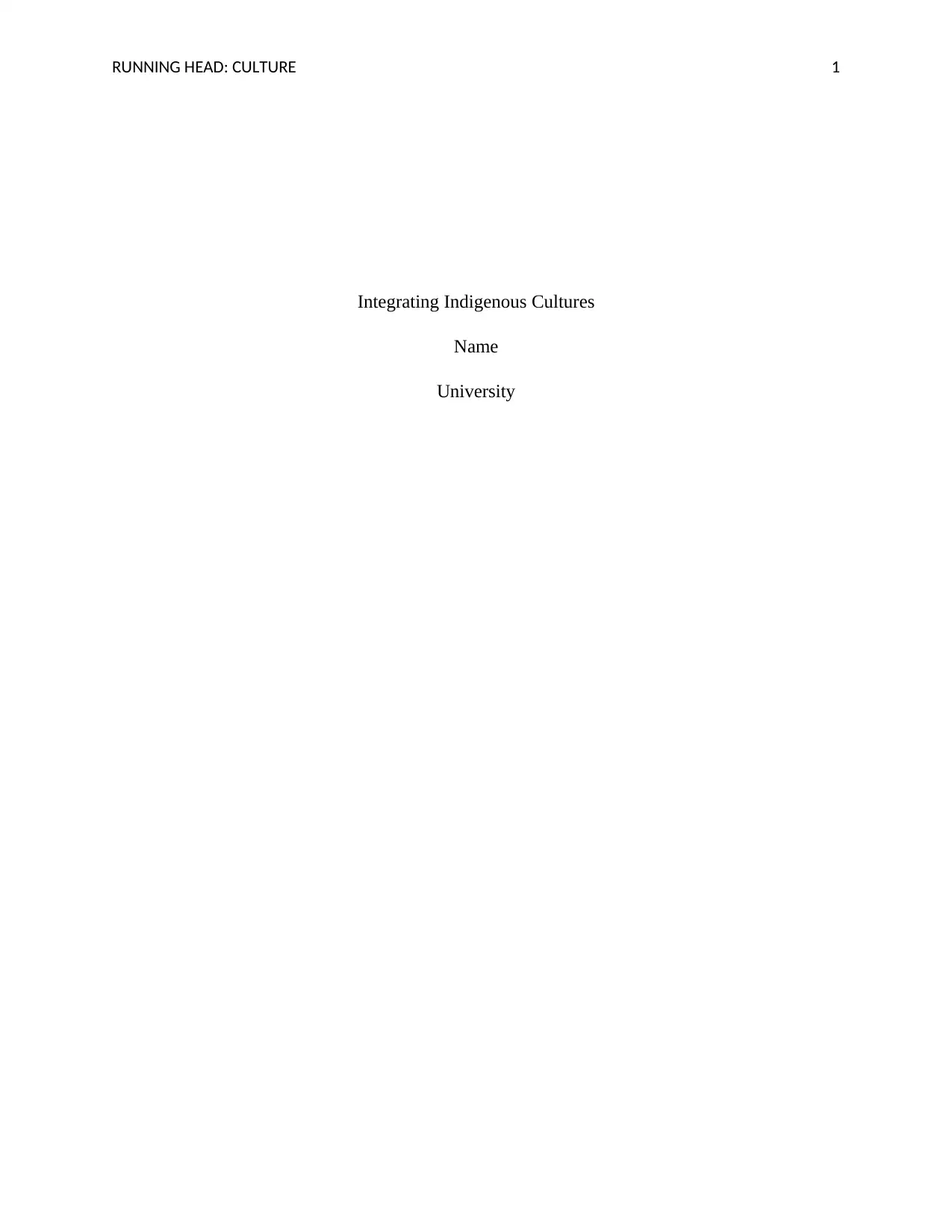
RUNNING HEAD: CULTURE 1
Integrating Indigenous Cultures
Name
University
Integrating Indigenous Cultures
Name
University
Paraphrase This Document
Need a fresh take? Get an instant paraphrase of this document with our AI Paraphraser
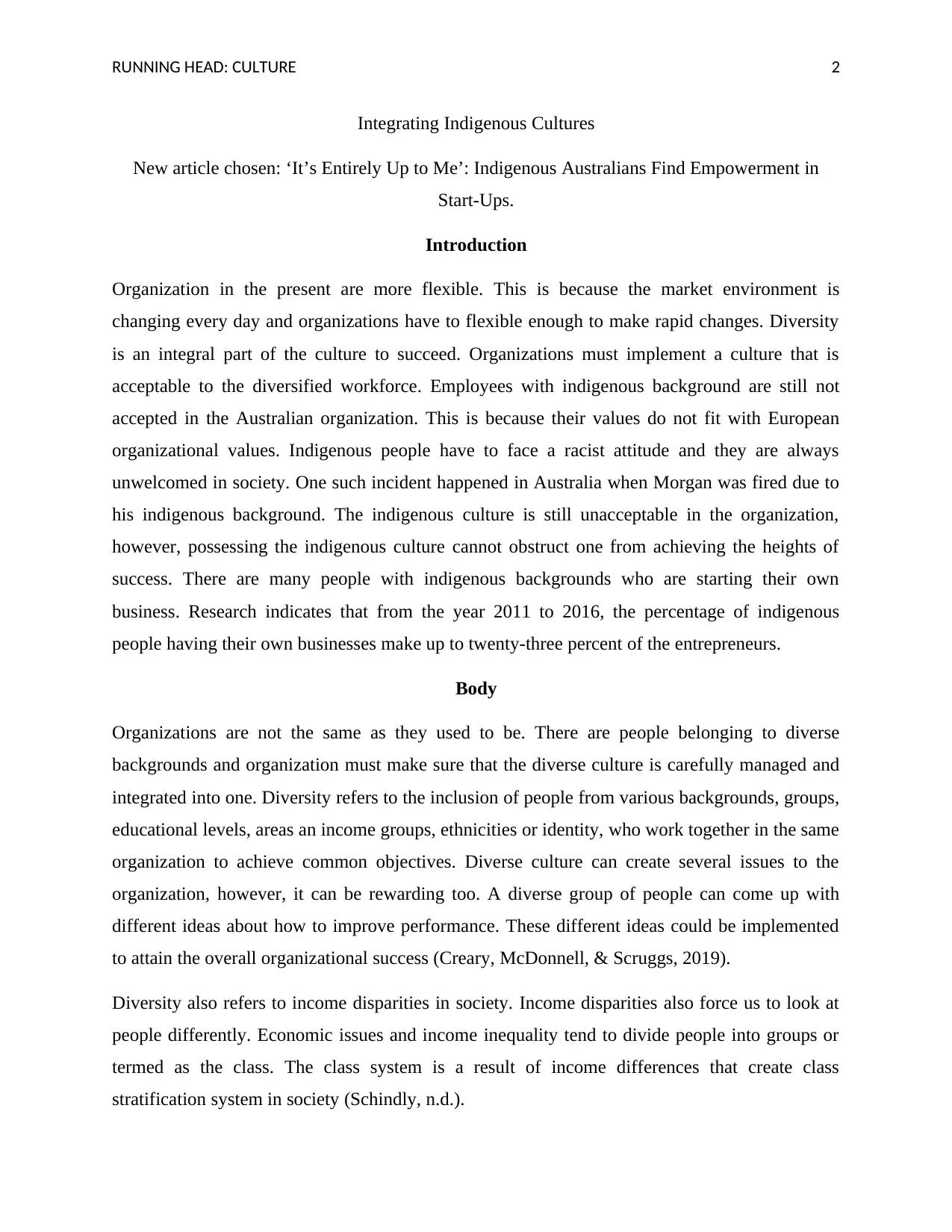
RUNNING HEAD: CULTURE 2
Integrating Indigenous Cultures
New article chosen: ‘It’s Entirely Up to Me’: Indigenous Australians Find Empowerment in
Start-Ups.
Introduction
Organization in the present are more flexible. This is because the market environment is
changing every day and organizations have to flexible enough to make rapid changes. Diversity
is an integral part of the culture to succeed. Organizations must implement a culture that is
acceptable to the diversified workforce. Employees with indigenous background are still not
accepted in the Australian organization. This is because their values do not fit with European
organizational values. Indigenous people have to face a racist attitude and they are always
unwelcomed in society. One such incident happened in Australia when Morgan was fired due to
his indigenous background. The indigenous culture is still unacceptable in the organization,
however, possessing the indigenous culture cannot obstruct one from achieving the heights of
success. There are many people with indigenous backgrounds who are starting their own
business. Research indicates that from the year 2011 to 2016, the percentage of indigenous
people having their own businesses make up to twenty-three percent of the entrepreneurs.
Body
Organizations are not the same as they used to be. There are people belonging to diverse
backgrounds and organization must make sure that the diverse culture is carefully managed and
integrated into one. Diversity refers to the inclusion of people from various backgrounds, groups,
educational levels, areas an income groups, ethnicities or identity, who work together in the same
organization to achieve common objectives. Diverse culture can create several issues to the
organization, however, it can be rewarding too. A diverse group of people can come up with
different ideas about how to improve performance. These different ideas could be implemented
to attain the overall organizational success (Creary, McDonnell, & Scruggs, 2019).
Diversity also refers to income disparities in society. Income disparities also force us to look at
people differently. Economic issues and income inequality tend to divide people into groups or
termed as the class. The class system is a result of income differences that create class
stratification system in society (Schindly, n.d.).
Integrating Indigenous Cultures
New article chosen: ‘It’s Entirely Up to Me’: Indigenous Australians Find Empowerment in
Start-Ups.
Introduction
Organization in the present are more flexible. This is because the market environment is
changing every day and organizations have to flexible enough to make rapid changes. Diversity
is an integral part of the culture to succeed. Organizations must implement a culture that is
acceptable to the diversified workforce. Employees with indigenous background are still not
accepted in the Australian organization. This is because their values do not fit with European
organizational values. Indigenous people have to face a racist attitude and they are always
unwelcomed in society. One such incident happened in Australia when Morgan was fired due to
his indigenous background. The indigenous culture is still unacceptable in the organization,
however, possessing the indigenous culture cannot obstruct one from achieving the heights of
success. There are many people with indigenous backgrounds who are starting their own
business. Research indicates that from the year 2011 to 2016, the percentage of indigenous
people having their own businesses make up to twenty-three percent of the entrepreneurs.
Body
Organizations are not the same as they used to be. There are people belonging to diverse
backgrounds and organization must make sure that the diverse culture is carefully managed and
integrated into one. Diversity refers to the inclusion of people from various backgrounds, groups,
educational levels, areas an income groups, ethnicities or identity, who work together in the same
organization to achieve common objectives. Diverse culture can create several issues to the
organization, however, it can be rewarding too. A diverse group of people can come up with
different ideas about how to improve performance. These different ideas could be implemented
to attain the overall organizational success (Creary, McDonnell, & Scruggs, 2019).
Diversity also refers to income disparities in society. Income disparities also force us to look at
people differently. Economic issues and income inequality tend to divide people into groups or
termed as the class. The class system is a result of income differences that create class
stratification system in society (Schindly, n.d.).
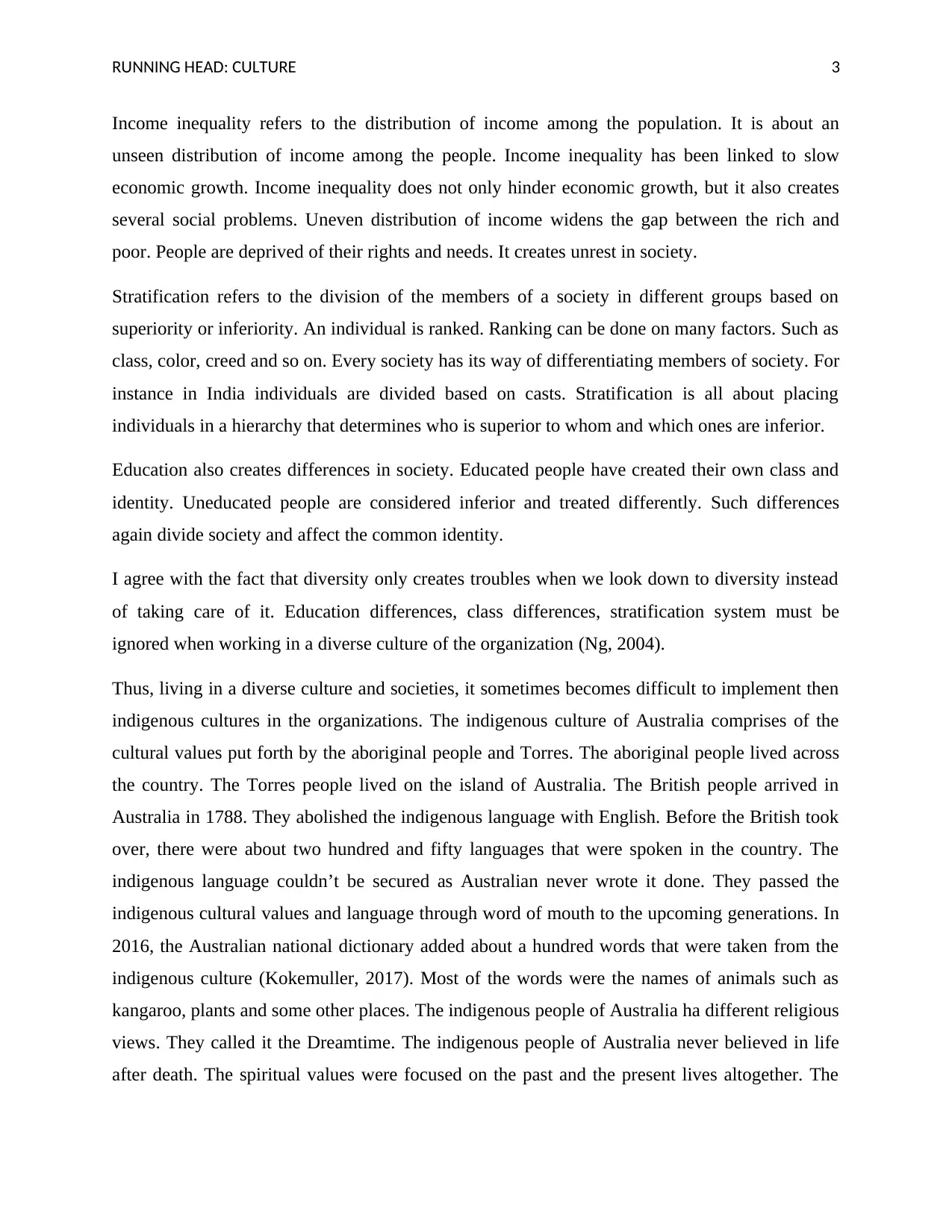
RUNNING HEAD: CULTURE 3
Income inequality refers to the distribution of income among the population. It is about an
unseen distribution of income among the people. Income inequality has been linked to slow
economic growth. Income inequality does not only hinder economic growth, but it also creates
several social problems. Uneven distribution of income widens the gap between the rich and
poor. People are deprived of their rights and needs. It creates unrest in society.
Stratification refers to the division of the members of a society in different groups based on
superiority or inferiority. An individual is ranked. Ranking can be done on many factors. Such as
class, color, creed and so on. Every society has its way of differentiating members of society. For
instance in India individuals are divided based on casts. Stratification is all about placing
individuals in a hierarchy that determines who is superior to whom and which ones are inferior.
Education also creates differences in society. Educated people have created their own class and
identity. Uneducated people are considered inferior and treated differently. Such differences
again divide society and affect the common identity.
I agree with the fact that diversity only creates troubles when we look down to diversity instead
of taking care of it. Education differences, class differences, stratification system must be
ignored when working in a diverse culture of the organization (Ng, 2004).
Thus, living in a diverse culture and societies, it sometimes becomes difficult to implement then
indigenous cultures in the organizations. The indigenous culture of Australia comprises of the
cultural values put forth by the aboriginal people and Torres. The aboriginal people lived across
the country. The Torres people lived on the island of Australia. The British people arrived in
Australia in 1788. They abolished the indigenous language with English. Before the British took
over, there were about two hundred and fifty languages that were spoken in the country. The
indigenous language couldn’t be secured as Australian never wrote it done. They passed the
indigenous cultural values and language through word of mouth to the upcoming generations. In
2016, the Australian national dictionary added about a hundred words that were taken from the
indigenous culture (Kokemuller, 2017). Most of the words were the names of animals such as
kangaroo, plants and some other places. The indigenous people of Australia ha different religious
views. They called it the Dreamtime. The indigenous people of Australia never believed in life
after death. The spiritual values were focused on the past and the present lives altogether. The
Income inequality refers to the distribution of income among the population. It is about an
unseen distribution of income among the people. Income inequality has been linked to slow
economic growth. Income inequality does not only hinder economic growth, but it also creates
several social problems. Uneven distribution of income widens the gap between the rich and
poor. People are deprived of their rights and needs. It creates unrest in society.
Stratification refers to the division of the members of a society in different groups based on
superiority or inferiority. An individual is ranked. Ranking can be done on many factors. Such as
class, color, creed and so on. Every society has its way of differentiating members of society. For
instance in India individuals are divided based on casts. Stratification is all about placing
individuals in a hierarchy that determines who is superior to whom and which ones are inferior.
Education also creates differences in society. Educated people have created their own class and
identity. Uneducated people are considered inferior and treated differently. Such differences
again divide society and affect the common identity.
I agree with the fact that diversity only creates troubles when we look down to diversity instead
of taking care of it. Education differences, class differences, stratification system must be
ignored when working in a diverse culture of the organization (Ng, 2004).
Thus, living in a diverse culture and societies, it sometimes becomes difficult to implement then
indigenous cultures in the organizations. The indigenous culture of Australia comprises of the
cultural values put forth by the aboriginal people and Torres. The aboriginal people lived across
the country. The Torres people lived on the island of Australia. The British people arrived in
Australia in 1788. They abolished the indigenous language with English. Before the British took
over, there were about two hundred and fifty languages that were spoken in the country. The
indigenous language couldn’t be secured as Australian never wrote it done. They passed the
indigenous cultural values and language through word of mouth to the upcoming generations. In
2016, the Australian national dictionary added about a hundred words that were taken from the
indigenous culture (Kokemuller, 2017). Most of the words were the names of animals such as
kangaroo, plants and some other places. The indigenous people of Australia ha different religious
views. They called it the Dreamtime. The indigenous people of Australia never believed in life
after death. The spiritual values were focused on the past and the present lives altogether. The
⊘ This is a preview!⊘
Do you want full access?
Subscribe today to unlock all pages.

Trusted by 1+ million students worldwide
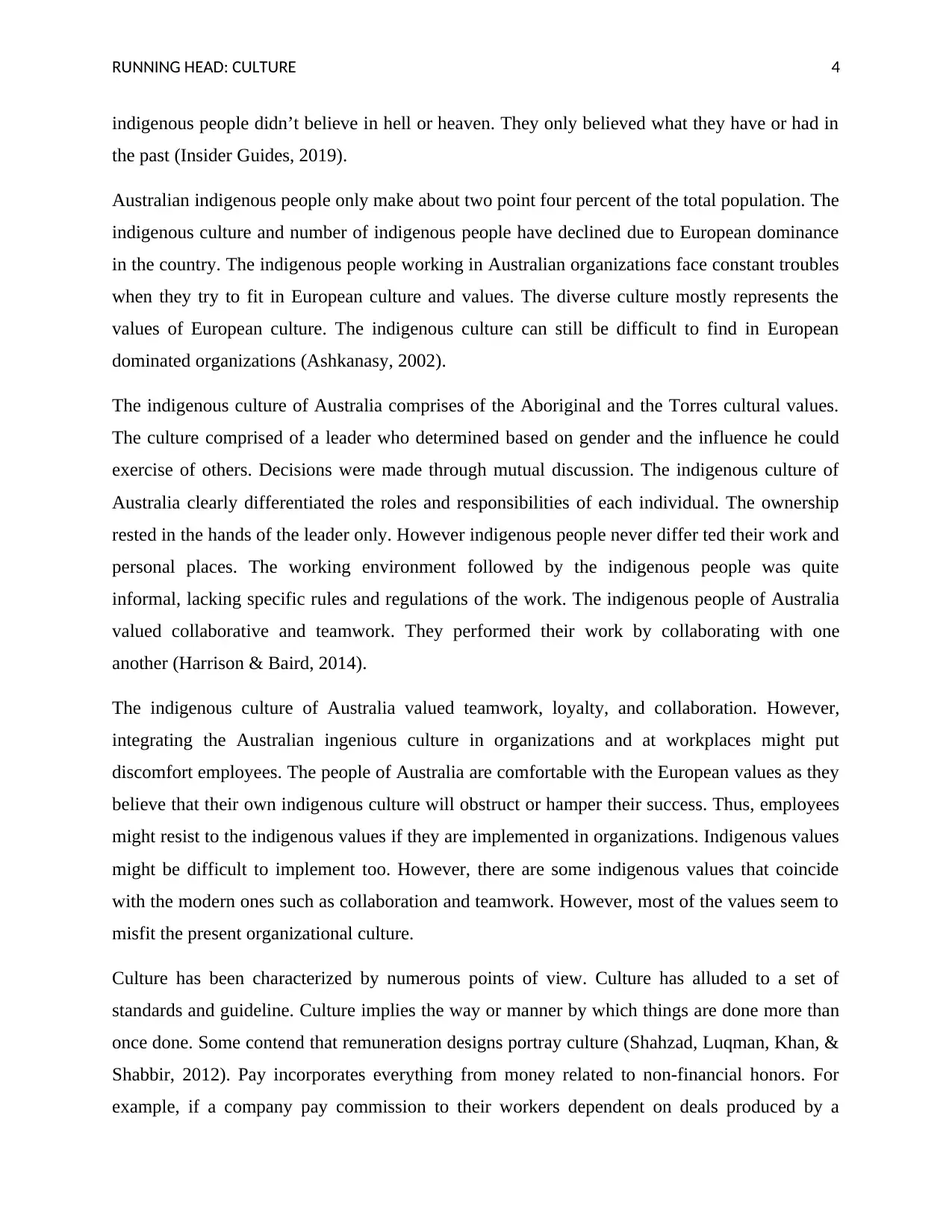
RUNNING HEAD: CULTURE 4
indigenous people didn’t believe in hell or heaven. They only believed what they have or had in
the past (Insider Guides, 2019).
Australian indigenous people only make about two point four percent of the total population. The
indigenous culture and number of indigenous people have declined due to European dominance
in the country. The indigenous people working in Australian organizations face constant troubles
when they try to fit in European culture and values. The diverse culture mostly represents the
values of European culture. The indigenous culture can still be difficult to find in European
dominated organizations (Ashkanasy, 2002).
The indigenous culture of Australia comprises of the Aboriginal and the Torres cultural values.
The culture comprised of a leader who determined based on gender and the influence he could
exercise of others. Decisions were made through mutual discussion. The indigenous culture of
Australia clearly differentiated the roles and responsibilities of each individual. The ownership
rested in the hands of the leader only. However indigenous people never differ ted their work and
personal places. The working environment followed by the indigenous people was quite
informal, lacking specific rules and regulations of the work. The indigenous people of Australia
valued collaborative and teamwork. They performed their work by collaborating with one
another (Harrison & Baird, 2014).
The indigenous culture of Australia valued teamwork, loyalty, and collaboration. However,
integrating the Australian ingenious culture in organizations and at workplaces might put
discomfort employees. The people of Australia are comfortable with the European values as they
believe that their own indigenous culture will obstruct or hamper their success. Thus, employees
might resist to the indigenous values if they are implemented in organizations. Indigenous values
might be difficult to implement too. However, there are some indigenous values that coincide
with the modern ones such as collaboration and teamwork. However, most of the values seem to
misfit the present organizational culture.
Culture has been characterized by numerous points of view. Culture has alluded to a set of
standards and guideline. Culture implies the way or manner by which things are done more than
once done. Some contend that remuneration designs portray culture (Shahzad, Luqman, Khan, &
Shabbir, 2012). Pay incorporates everything from money related to non-financial honors. For
example, if a company pay commission to their workers dependent on deals produced by a
indigenous people didn’t believe in hell or heaven. They only believed what they have or had in
the past (Insider Guides, 2019).
Australian indigenous people only make about two point four percent of the total population. The
indigenous culture and number of indigenous people have declined due to European dominance
in the country. The indigenous people working in Australian organizations face constant troubles
when they try to fit in European culture and values. The diverse culture mostly represents the
values of European culture. The indigenous culture can still be difficult to find in European
dominated organizations (Ashkanasy, 2002).
The indigenous culture of Australia comprises of the Aboriginal and the Torres cultural values.
The culture comprised of a leader who determined based on gender and the influence he could
exercise of others. Decisions were made through mutual discussion. The indigenous culture of
Australia clearly differentiated the roles and responsibilities of each individual. The ownership
rested in the hands of the leader only. However indigenous people never differ ted their work and
personal places. The working environment followed by the indigenous people was quite
informal, lacking specific rules and regulations of the work. The indigenous people of Australia
valued collaborative and teamwork. They performed their work by collaborating with one
another (Harrison & Baird, 2014).
The indigenous culture of Australia valued teamwork, loyalty, and collaboration. However,
integrating the Australian ingenious culture in organizations and at workplaces might put
discomfort employees. The people of Australia are comfortable with the European values as they
believe that their own indigenous culture will obstruct or hamper their success. Thus, employees
might resist to the indigenous values if they are implemented in organizations. Indigenous values
might be difficult to implement too. However, there are some indigenous values that coincide
with the modern ones such as collaboration and teamwork. However, most of the values seem to
misfit the present organizational culture.
Culture has been characterized by numerous points of view. Culture has alluded to a set of
standards and guideline. Culture implies the way or manner by which things are done more than
once done. Some contend that remuneration designs portray culture (Shahzad, Luqman, Khan, &
Shabbir, 2012). Pay incorporates everything from money related to non-financial honors. For
example, if a company pay commission to their workers dependent on deals produced by a
Paraphrase This Document
Need a fresh take? Get an instant paraphrase of this document with our AI Paraphraser
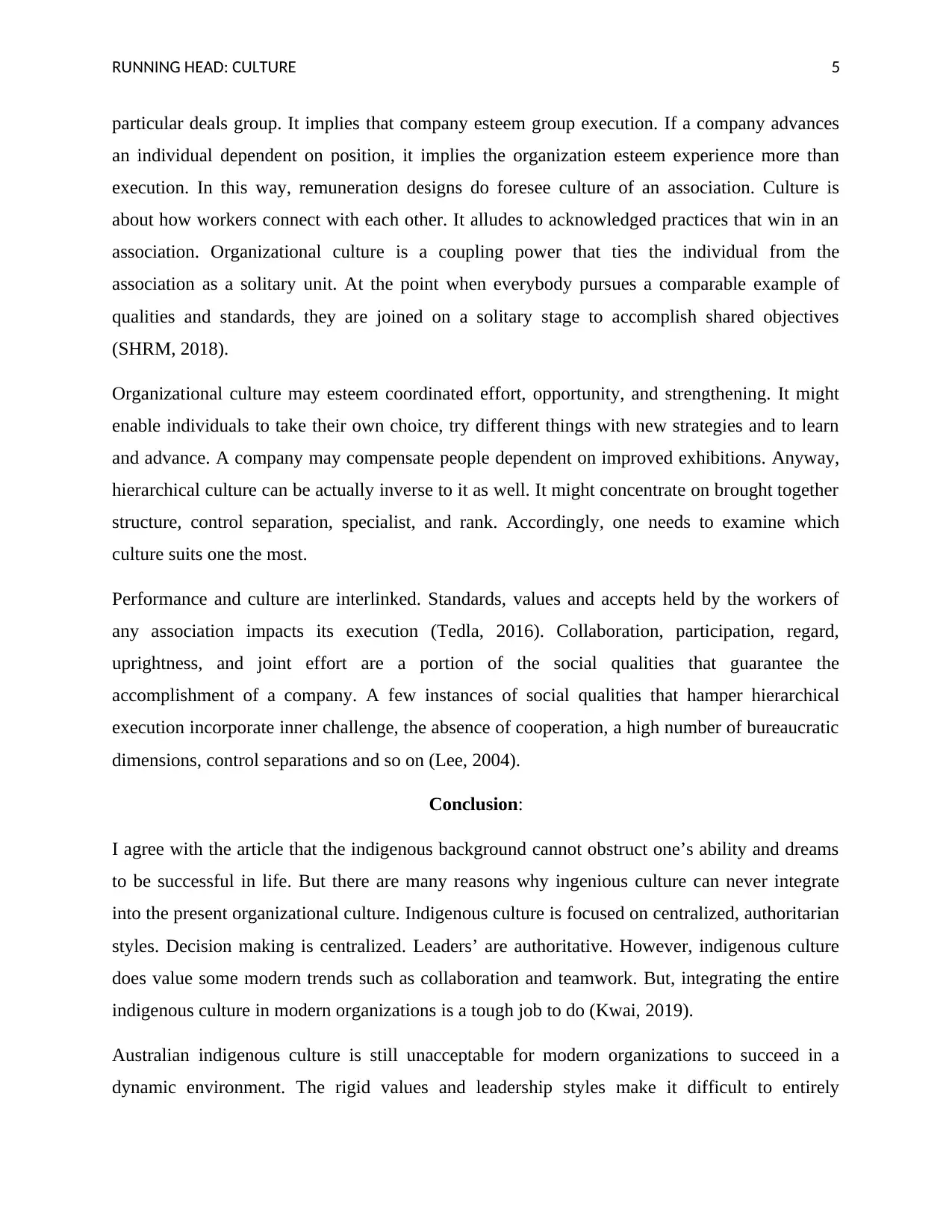
RUNNING HEAD: CULTURE 5
particular deals group. It implies that company esteem group execution. If a company advances
an individual dependent on position, it implies the organization esteem experience more than
execution. In this way, remuneration designs do foresee culture of an association. Culture is
about how workers connect with each other. It alludes to acknowledged practices that win in an
association. Organizational culture is a coupling power that ties the individual from the
association as a solitary unit. At the point when everybody pursues a comparable example of
qualities and standards, they are joined on a solitary stage to accomplish shared objectives
(SHRM, 2018).
Organizational culture may esteem coordinated effort, opportunity, and strengthening. It might
enable individuals to take their own choice, try different things with new strategies and to learn
and advance. A company may compensate people dependent on improved exhibitions. Anyway,
hierarchical culture can be actually inverse to it as well. It might concentrate on brought together
structure, control separation, specialist, and rank. Accordingly, one needs to examine which
culture suits one the most.
Performance and culture are interlinked. Standards, values and accepts held by the workers of
any association impacts its execution (Tedla, 2016). Collaboration, participation, regard,
uprightness, and joint effort are a portion of the social qualities that guarantee the
accomplishment of a company. A few instances of social qualities that hamper hierarchical
execution incorporate inner challenge, the absence of cooperation, a high number of bureaucratic
dimensions, control separations and so on (Lee, 2004).
Conclusion:
I agree with the article that the indigenous background cannot obstruct one’s ability and dreams
to be successful in life. But there are many reasons why ingenious culture can never integrate
into the present organizational culture. Indigenous culture is focused on centralized, authoritarian
styles. Decision making is centralized. Leaders’ are authoritative. However, indigenous culture
does value some modern trends such as collaboration and teamwork. But, integrating the entire
indigenous culture in modern organizations is a tough job to do (Kwai, 2019).
Australian indigenous culture is still unacceptable for modern organizations to succeed in a
dynamic environment. The rigid values and leadership styles make it difficult to entirely
particular deals group. It implies that company esteem group execution. If a company advances
an individual dependent on position, it implies the organization esteem experience more than
execution. In this way, remuneration designs do foresee culture of an association. Culture is
about how workers connect with each other. It alludes to acknowledged practices that win in an
association. Organizational culture is a coupling power that ties the individual from the
association as a solitary unit. At the point when everybody pursues a comparable example of
qualities and standards, they are joined on a solitary stage to accomplish shared objectives
(SHRM, 2018).
Organizational culture may esteem coordinated effort, opportunity, and strengthening. It might
enable individuals to take their own choice, try different things with new strategies and to learn
and advance. A company may compensate people dependent on improved exhibitions. Anyway,
hierarchical culture can be actually inverse to it as well. It might concentrate on brought together
structure, control separation, specialist, and rank. Accordingly, one needs to examine which
culture suits one the most.
Performance and culture are interlinked. Standards, values and accepts held by the workers of
any association impacts its execution (Tedla, 2016). Collaboration, participation, regard,
uprightness, and joint effort are a portion of the social qualities that guarantee the
accomplishment of a company. A few instances of social qualities that hamper hierarchical
execution incorporate inner challenge, the absence of cooperation, a high number of bureaucratic
dimensions, control separations and so on (Lee, 2004).
Conclusion:
I agree with the article that the indigenous background cannot obstruct one’s ability and dreams
to be successful in life. But there are many reasons why ingenious culture can never integrate
into the present organizational culture. Indigenous culture is focused on centralized, authoritarian
styles. Decision making is centralized. Leaders’ are authoritative. However, indigenous culture
does value some modern trends such as collaboration and teamwork. But, integrating the entire
indigenous culture in modern organizations is a tough job to do (Kwai, 2019).
Australian indigenous culture is still unacceptable for modern organizations to succeed in a
dynamic environment. The rigid values and leadership styles make it difficult to entirely
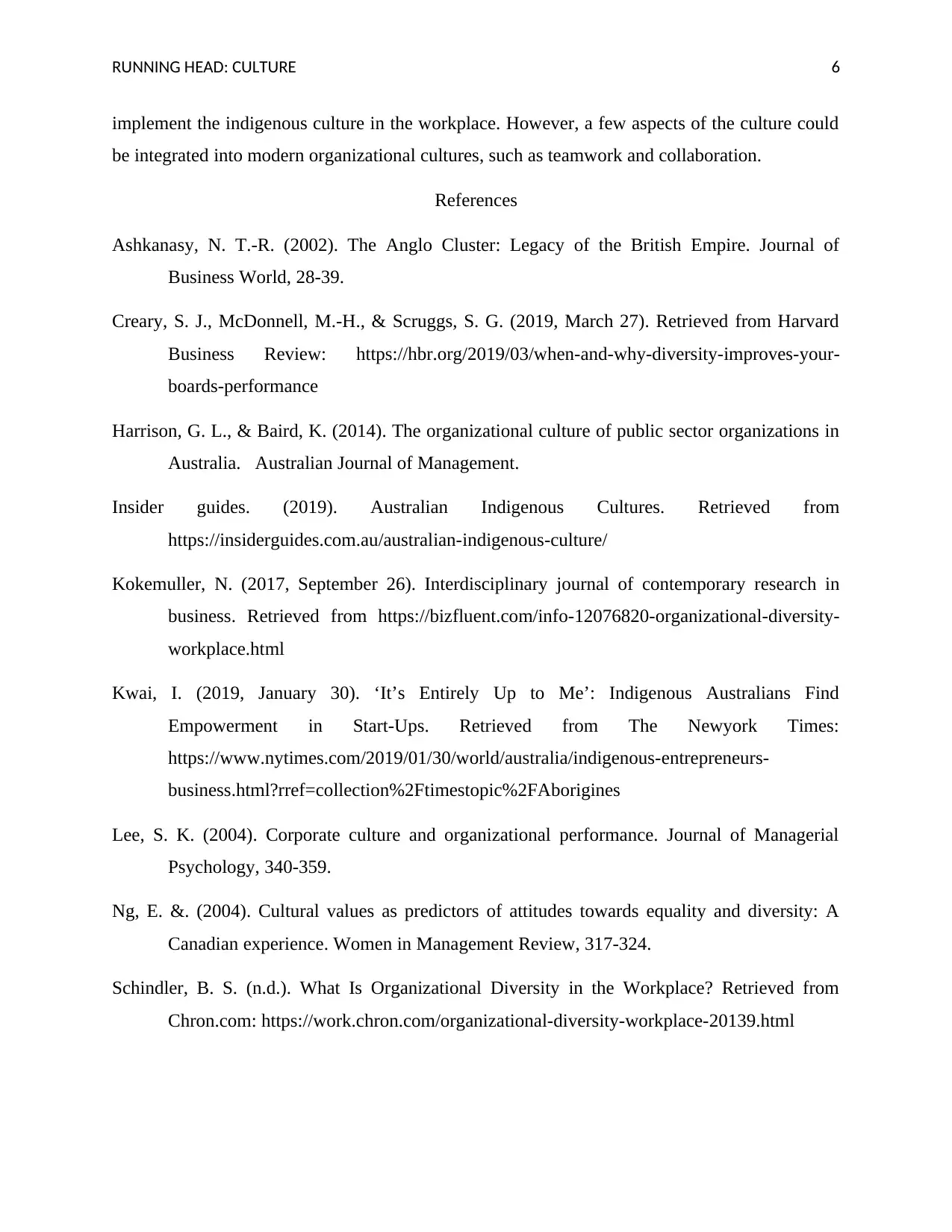
RUNNING HEAD: CULTURE 6
implement the indigenous culture in the workplace. However, a few aspects of the culture could
be integrated into modern organizational cultures, such as teamwork and collaboration.
References
Ashkanasy, N. T.-R. (2002). The Anglo Cluster: Legacy of the British Empire. Journal of
Business World, 28-39.
Creary, S. J., McDonnell, M.-H., & Scruggs, S. G. (2019, March 27). Retrieved from Harvard
Business Review: https://hbr.org/2019/03/when-and-why-diversity-improves-your-
boards-performance
Harrison, G. L., & Baird, K. (2014). The organizational culture of public sector organizations in
Australia. Australian Journal of Management.
Insider guides. (2019). Australian Indigenous Cultures. Retrieved from
https://insiderguides.com.au/australian-indigenous-culture/
Kokemuller, N. (2017, September 26). Interdisciplinary journal of contemporary research in
business. Retrieved from https://bizfluent.com/info-12076820-organizational-diversity-
workplace.html
Kwai, I. (2019, January 30). ‘It’s Entirely Up to Me’: Indigenous Australians Find
Empowerment in Start-Ups. Retrieved from The Newyork Times:
https://www.nytimes.com/2019/01/30/world/australia/indigenous-entrepreneurs-
business.html?rref=collection%2Ftimestopic%2FAborigines
Lee, S. K. (2004). Corporate culture and organizational performance. Journal of Managerial
Psychology, 340-359.
Ng, E. &. (2004). Cultural values as predictors of attitudes towards equality and diversity: A
Canadian experience. Women in Management Review, 317-324.
Schindler, B. S. (n.d.). What Is Organizational Diversity in the Workplace? Retrieved from
Chron.com: https://work.chron.com/organizational-diversity-workplace-20139.html
implement the indigenous culture in the workplace. However, a few aspects of the culture could
be integrated into modern organizational cultures, such as teamwork and collaboration.
References
Ashkanasy, N. T.-R. (2002). The Anglo Cluster: Legacy of the British Empire. Journal of
Business World, 28-39.
Creary, S. J., McDonnell, M.-H., & Scruggs, S. G. (2019, March 27). Retrieved from Harvard
Business Review: https://hbr.org/2019/03/when-and-why-diversity-improves-your-
boards-performance
Harrison, G. L., & Baird, K. (2014). The organizational culture of public sector organizations in
Australia. Australian Journal of Management.
Insider guides. (2019). Australian Indigenous Cultures. Retrieved from
https://insiderguides.com.au/australian-indigenous-culture/
Kokemuller, N. (2017, September 26). Interdisciplinary journal of contemporary research in
business. Retrieved from https://bizfluent.com/info-12076820-organizational-diversity-
workplace.html
Kwai, I. (2019, January 30). ‘It’s Entirely Up to Me’: Indigenous Australians Find
Empowerment in Start-Ups. Retrieved from The Newyork Times:
https://www.nytimes.com/2019/01/30/world/australia/indigenous-entrepreneurs-
business.html?rref=collection%2Ftimestopic%2FAborigines
Lee, S. K. (2004). Corporate culture and organizational performance. Journal of Managerial
Psychology, 340-359.
Ng, E. &. (2004). Cultural values as predictors of attitudes towards equality and diversity: A
Canadian experience. Women in Management Review, 317-324.
Schindler, B. S. (n.d.). What Is Organizational Diversity in the Workplace? Retrieved from
Chron.com: https://work.chron.com/organizational-diversity-workplace-20139.html
⊘ This is a preview!⊘
Do you want full access?
Subscribe today to unlock all pages.

Trusted by 1+ million students worldwide
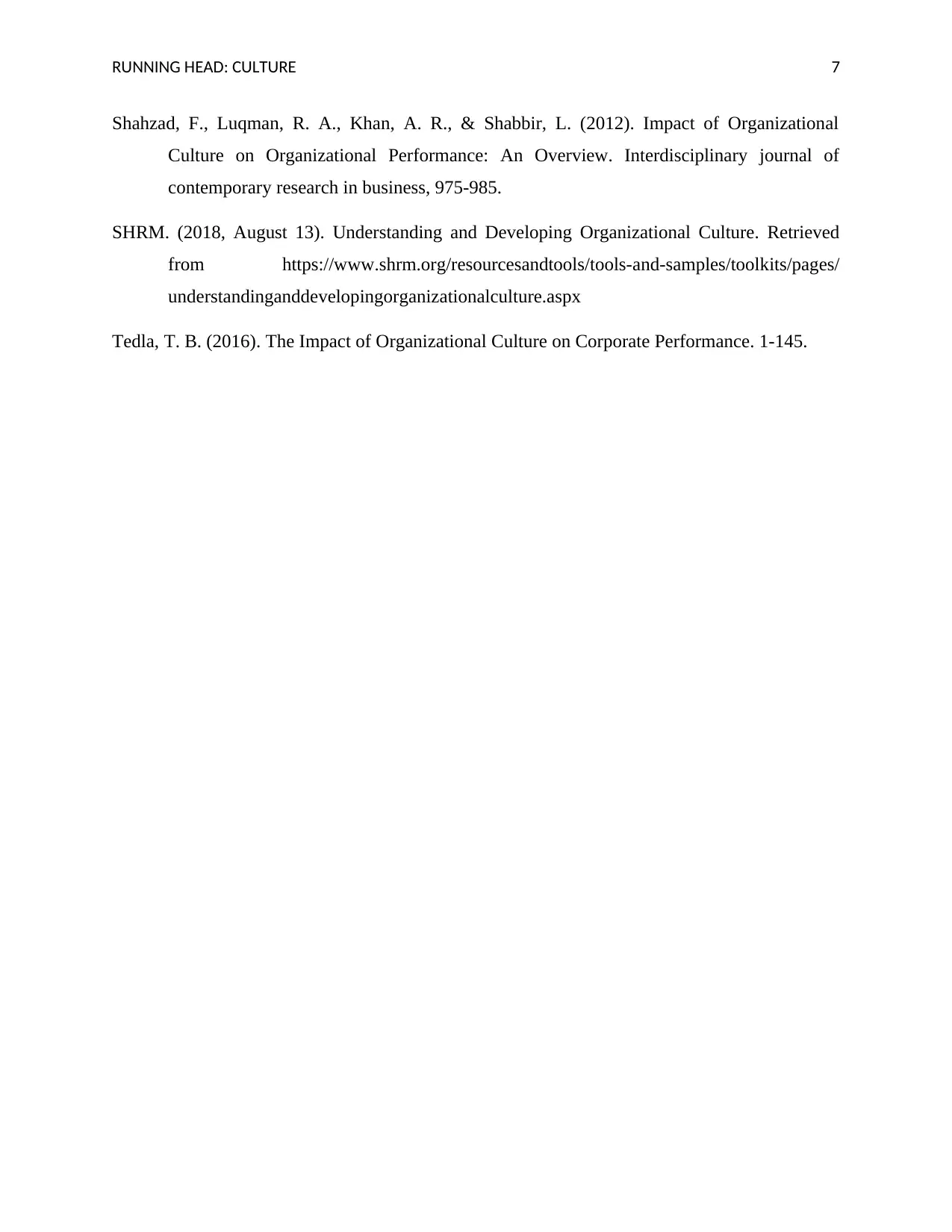
RUNNING HEAD: CULTURE 7
Shahzad, F., Luqman, R. A., Khan, A. R., & Shabbir, L. (2012). Impact of Organizational
Culture on Organizational Performance: An Overview. Interdisciplinary journal of
contemporary research in business, 975-985.
SHRM. (2018, August 13). Understanding and Developing Organizational Culture. Retrieved
from https://www.shrm.org/resourcesandtools/tools-and-samples/toolkits/pages/
understandinganddevelopingorganizationalculture.aspx
Tedla, T. B. (2016). The Impact of Organizational Culture on Corporate Performance. 1-145.
Shahzad, F., Luqman, R. A., Khan, A. R., & Shabbir, L. (2012). Impact of Organizational
Culture on Organizational Performance: An Overview. Interdisciplinary journal of
contemporary research in business, 975-985.
SHRM. (2018, August 13). Understanding and Developing Organizational Culture. Retrieved
from https://www.shrm.org/resourcesandtools/tools-and-samples/toolkits/pages/
understandinganddevelopingorganizationalculture.aspx
Tedla, T. B. (2016). The Impact of Organizational Culture on Corporate Performance. 1-145.
1 out of 7
Related Documents
Your All-in-One AI-Powered Toolkit for Academic Success.
+13062052269
info@desklib.com
Available 24*7 on WhatsApp / Email
![[object Object]](/_next/static/media/star-bottom.7253800d.svg)
Unlock your academic potential
Copyright © 2020–2025 A2Z Services. All Rights Reserved. Developed and managed by ZUCOL.




